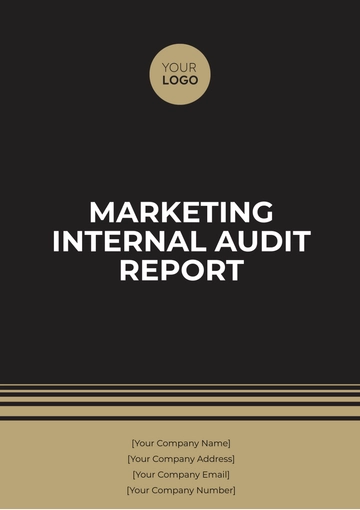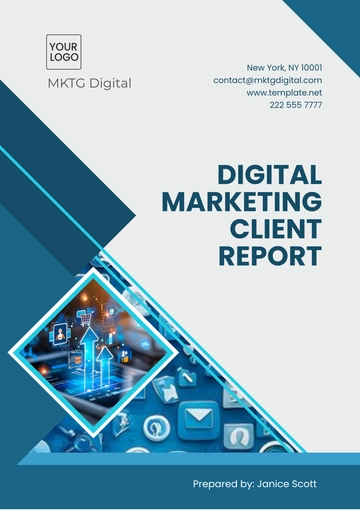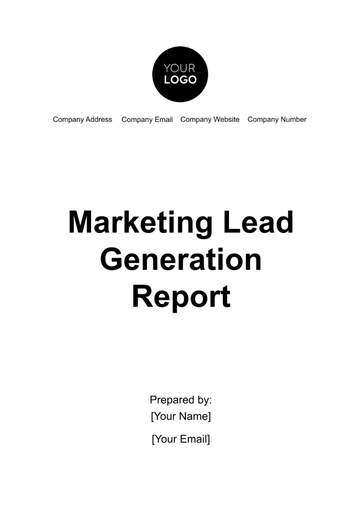Free Marketing Lead Generation Report

I. Executive Summary
A. Overview of Lead Generation Objectives
The primary objective of [Your Company Name]'s lead generation initiatives was to significantly boost the number of high-quality leads for our sales team, ultimately driving increased revenue. We aimed to achieve this by leveraging a diverse set of marketing channels tailored to our target audience. [Your Company Name]'s focus was on optimizing strategies to enhance both lead volume and lead quality, ensuring a stronger pipeline for future sales.
B. Key Findings and Highlights
[Your Company Name] lead generation efforts resulted in a [00]% increase in the total number of leads compared to the previous quarter, demonstrating significant progress. Content marketing emerged as the most effective channel, accounting for [00]% of the total leads generated. Additionally, social media campaigns contributed substantially, showing a notable engagement rate and lead conversion success.
C. Recommendations for Future Strategies
To capitalize on [Your Company Name] successes, we recommend amplifying our content marketing efforts, which have proven to be highly effective in attracting and converting leads. Investing in advanced social media tools and techniques could further enhance our reach and engagement. Exploring partnerships with industry influencers and expanding into new digital advertising platforms may also provide additional growth opportunities.
II. Introduction
A. Purpose of the Report
This report aims to provide a comprehensive analysis of our lead generation activities over the past quarter, evaluating the effectiveness of the strategies employed. It will present detailed performance metrics and offer actionable insights to guide future lead generation efforts. The goal is to assess what worked well and identify areas where improvements can be made.
B. Scope and Methodology
The scope of this report includes an examination of all lead generation activities conducted from January to March 2024. Data was collected from various sources, including CRM systems, marketing automation tools, and campaign analytics platforms. Our methodology involved analyzing this data to assess the performance of different strategies and channels.
C. Definitions and Key Terms
Lead
A lead is a potential customer who has expressed interest in our products or services, often through various touchpoints such as downloads or sign-ups.
Conversion Rate
The conversion rate is a metric that indicates the percentage of leads who have successfully moved through the sales funnel to become paying customers.
Cost Per Lead (CPL)
CPL refers to the average expenditure incurred to acquire a single lead, calculated by dividing total lead generation costs by the number of leads generated.
III. Lead Generation Strategies
A. Overview of Strategies Used
Our lead generation strategy encompassed multiple channels to maximize reach and engagement. Content Marketing involved creating valuable resources such as blog posts, whitepapers, and eBooks to attract and nurture leads. Social Media Marketing leveraged targeted ads and engaging posts across platforms like LinkedIn and Facebook to drive traffic and generate interest.
B. Objectives of Each Strategy
The primary objective of Content Marketing was to establish thought leadership and provide valuable information that would attract and retain leads. Social Media Marketing aimed to enhance brand visibility and facilitate direct interaction with potential leads through targeted advertising and organic engagement. Email Marketing focused on nurturing leads through personalized communication and offers to guide them through the conversion process.
C. Target Audience and Segmentation
Our target audience comprised mid-sized business owners and decision-makers within the technology sector, chosen for their alignment with our product offerings. Segmentation was conducted based on key criteria such as company size, industry, and job role to ensure tailored and relevant messaging. By focusing on these segments, we aimed to deliver more personalized and effective marketing communications.
III. Lead Generation Strategies
A. Overview of Strategies Used
Our lead generation strategy employed a multi-channel approach, utilizing Content Marketing to drive organic traffic and engage potential leads through informative blog posts, in-depth whitepapers, and interactive eBooks. Social Media Marketing was leveraged to increase brand visibility and generate leads through targeted ads and engaging organic posts on platforms like LinkedIn, Facebook, and Twitter. Additionally, Email Marketing played a crucial role in nurturing leads by delivering personalized content and offers, while Paid Advertising was used to target specific demographics and drive immediate traffic to lead capture pages.
B. Objectives of Each Strategy
The objective of Content Marketing was to create valuable, informative content that could attract high-quality leads and establish our brand as a thought leader in the industry. Social Media Marketing aimed to engage with a broader audience and foster community interaction, driving traffic to our website and lead capture forms. Email Marketing sought to nurture leads through a series of personalized campaigns designed to move prospects through the sales funnel, while Paid Advertising focused on reaching new audiences quickly and efficiently with compelling offers and calls to action.
C. Target Audience and Segmentation
Our primary target audience consisted of mid-sized business owners and senior decision-makers within the technology sector, who are responsible for driving digital transformation within their organizations. We segmented our audience based on factors such as company size, industry vertical, and decision-making role to ensure that our messaging resonated with each segment. This segmentation allowed us to tailor content and campaigns to meet the specific needs and pain points of each group, resulting in more effective lead generation.
IV. Performance Metrics
A. Lead Volume
During the last quarter, we generated a total of 5,000 leads, representing a [00]% increase from the previous period. The majority of these leads were sourced through content marketing and social media, which accounted for [00]% and [00]% of the total leads, respectively. The following table provides a breakdown of leads by source:
Source | Leads Generated | Percentage of Total Leads |
|---|---|---|
Content Marketing | [00] | [00]% |
Social Media | [00] | [00]% |
Email Marketing | [00] | [00]% |
Paid Advertising | [00] | [00]% |
B. Conversion Rates
Our overall lead-to-customer conversion rate for the quarter was [00]%, an improvement from the previous quarter’s rate of [00]%. Conversion rates varied by channel, with content marketing leading the way at [00]%, followed by social media at 7%. The conversion rate from paid advertising was lower at [00]%, indicating the need for further optimization in this area.
C. Cost Analysis
The average cost per lead (CPL) was calculated at $[00], with the highest costs attributed to paid advertising. Content marketing proved to be the most cost-effective, with a CPL of $[00], due to the lower ongoing costs associated with content creation and organic traffic generation. The following table details the CPL by channel:
Channel | Cost Per Lead (CPL) |
|---|---|
Content Marketing | $[00] |
Social Media | $[00] |
Email Marketing | $[00] |
Paid Advertising | $[00] |
V. Lead Sources and Quality
A. Source Analysis
Organic sources, including content marketing and social media, contributed [00]% of the total leads, while paid sources accounted for [00]%. The effectiveness of organic sources was evident in the higher engagement and conversion rates observed. Referral programs and strategic partnerships also played a significant role, generating [00]% of the leads and bringing in high-quality prospects through trusted networks.
B. Quality of Leads
Leads were scored using a lead scoring model that evaluated factors such as engagement level, company size, and job role relevance. High-quality leads were those that engaged with multiple content pieces, attended webinars, and fit our target demographic profile. The majority of high-scoring leads came from content marketing, highlighting the effectiveness of this channel in attracting engaged and qualified prospects.
VI. Campaign Analysis
A. Overview of Key Campaigns
Key campaigns this quarter included the "Tech Trends Webinar" and the "Ultimate Guide to Digital Transformation" eBook. These campaigns were designed to attract senior-level decision-makers in the technology sector and provide them with valuable insights into the latest industry trends. Both campaigns were heavily promoted through content marketing, social media, and email marketing channels.
B. Performance of Each Campaign
The "Tech Trends Webinar" attracted 1,200 participants, resulting in 1,000 new leads, with a conversion rate of [00]%. The "Ultimate Guide to Digital Transformation" eBook campaign generated 1,500 downloads and 1,000 new leads, with a similar conversion rate. Despite the success of these campaigns, challenges such as lower-than-expected participation in paid advertising campaigns were noted, requiring further analysis and optimization.
C. Lessons Learned
The success of the "Tech Trends Webinar" and eBook campaigns highlights the value of providing high-quality, informative content tailored to the needs of our target audience. However, the challenges faced with paid advertising suggest the need for better targeting and message optimization. Future campaigns should continue to focus on content-rich offerings while exploring ways to enhance the performance of paid media.
VII. Comparative Analysis
A. Benchmarking Against Industry Standards
Our lead generation performance surpassed industry benchmarks, particularly in content marketing, where our lead volume and conversion rates were significantly higher than average. Industry standards typically report a [00]% conversion rate for content marketing, while we achieved a [00]% rate. This indicates that our content strategy is highly effective and well-received by our target audience.
B. Comparison with Previous Periods
Compared to the previous quarter, we observed a [00]% increase in lead volume and a [00]% improvement in conversion rates. This growth can be attributed to the refinement of our content marketing and social media strategies, as well as the introduction of new, engaging content formats such as webinars and eBooks. The following table compares key metrics from the last two quarters:
Metric | Q1 [Year] | Q4 [Year] | Percentage Change |
|---|---|---|---|
Total Leads Generated | [00] | [00] | [00]% |
Conversion Rate | [00] | [00] | [00]% |
Cost Per Lead (CPL) | [00] | [00] | [00]% |
C. Competitive Analysis
Our competitors have also been active in lead generation, but our content marketing efforts have outperformed theirs, particularly in lead quality and engagement metrics. Competitor analysis indicates that while other companies have strong social media presences, they struggle with content marketing effectiveness. Our superior performance in this area suggests a competitive advantage that we should continue to leverage.
VIII. Recommendations
A. Strategies for Improving Lead Generation
To further improve our lead generation efforts, we recommend focusing on content personalization. By tailoring content to the specific needs and interests of segmented audiences, we can increase engagement and conversion rates. Additionally, investing in advanced analytics tools will allow us to better understand lead behavior and refine our strategies accordingly, ensuring that we target the right prospects with the right messages at the right time.
B. Optimization of Current Campaigns
For optimization, we should enhance our paid advertising campaigns by refining our targeting criteria and A/B testing different ad creatives and messaging. This will help us reduce the cost per lead and improve the conversion rate. Furthermore, we should expand our email marketing efforts by implementing automated drip campaigns that nurture leads over time, keeping them engaged and moving them closer to making a purchase decision.
C. Suggested New Approaches and Channels
Exploring new channels such as influencer marketing and partnerships with industry blogs could open up additional avenues for lead generation. Influencer marketing, in particular, can help us reach a broader audience through trusted voices in the industry. We should also consider leveraging emerging platforms like podcasts and webinars to engage with potential leads in a more interactive and informative manner.
IX. Conclusion
A. Summary of Key Insights
Our lead generation strategies over the past quarter have been largely successful, with a [00]% increase in lead volume and significant improvements in conversion rates. Content marketing and social media channels have proven to be the most effective, delivering the highest number of leads and the best engagement rates. However, there is still room for improvement in optimizing paid advertising and exploring new lead generation channels.
B. Final Recommendations
To build on our successes, we recommend continuing to invest in content marketing and social media, while refining our paid advertising strategies. Increasing the personalization of our content and expanding into new channels like influencer marketing could further enhance our lead generation efforts. Additionally, implementing advanced analytics will help us fine-tune our strategies and ensure we are maximizing our lead generation potential.
C. Next Steps
Moving forward, we will implement the recommended optimizations and explore new channels as part of our lead generation strategy for the next quarter. We will also set up a regular review process to monitor the performance of our campaigns and make adjustments as needed. The next steps include aligning our sales and marketing teams to ensure a seamless handoff of leads and improving our lead nurturing processes to drive higher conversions.
- 100% Customizable, free editor
- Access 1 Million+ Templates, photo’s & graphics
- Download or share as a template
- Click and replace photos, graphics, text, backgrounds
- Resize, crop, AI write & more
- Access advanced editor
Assess your marketing success with the Marketing Lead Generation Report Template from Template.net. This editable and customizable template allows you to efficiently track and analyze your lead generation efforts. Enhance your reports using the AI Editor Tool, ensuring accurate and professional content that adapts to your business needs, all in an easy-to-use format.
You may also like
- Sales Report
- Daily Report
- Project Report
- Business Report
- Weekly Report
- Incident Report
- Annual Report
- Report Layout
- Report Design
- Progress Report
- Marketing Report
- Company Report
- Monthly Report
- Audit Report
- Status Report
- School Report
- Reports Hr
- Management Report
- Project Status Report
- Handover Report
- Health And Safety Report
- Restaurant Report
- Construction Report
- Research Report
- Evaluation Report
- Investigation Report
- Employee Report
- Advertising Report
- Weekly Status Report
- Project Management Report
- Finance Report
- Service Report
- Technical Report
- Meeting Report
- Quarterly Report
- Inspection Report
- Medical Report
- Test Report
- Summary Report
- Inventory Report
- Valuation Report
- Operations Report
- Payroll Report
- Training Report
- Job Report
- Case Report
- Performance Report
- Board Report
- Internal Audit Report
- Student Report
- Monthly Management Report
- Small Business Report
- Accident Report
- Call Center Report
- Activity Report
- IT and Software Report
- Internship Report
- Visit Report
- Product Report
- Book Report
- Property Report
- Recruitment Report
- University Report
- Event Report
- SEO Report
- Conference Report
- Narrative Report
- Nursing Home Report
- Preschool Report
- Call Report
- Customer Report
- Employee Incident Report
- Accomplishment Report
- Social Media Report
- Work From Home Report
- Security Report
- Damage Report
- Quality Report
- Internal Report
- Nurse Report
- Real Estate Report
- Hotel Report
- Equipment Report
- Credit Report
- Field Report
- Non Profit Report
- Maintenance Report
- News Report
- Survey Report
- Executive Report
- Law Firm Report
- Advertising Agency Report
- Interior Design Report
- Travel Agency Report
- Stock Report
- Salon Report
- Bug Report
- Workplace Report
- Action Report
- Investor Report
- Cleaning Services Report
- Consulting Report
- Freelancer Report
- Site Visit Report
- Trip Report
- Classroom Observation Report
- Vehicle Report
- Final Report
- Software Report





























